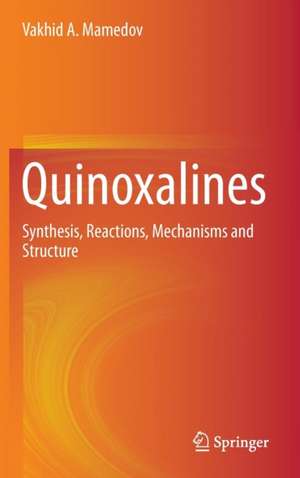Quinoxalines: Synthesis, Reactions, Mechanisms and Structure
Autor Vakhid A. Mamedoven Limba Engleză Hardback – 6 mai 2016
| Toate formatele și edițiile | Preț | Express |
|---|---|---|
| Paperback (1) | 648.24 lei 6-8 săpt. | |
| Springer International Publishing – 27 mai 2018 | 648.24 lei 6-8 săpt. | |
| Hardback (1) | 654.62 lei 6-8 săpt. | |
| Springer International Publishing – 6 mai 2016 | 654.62 lei 6-8 săpt. |
Preț: 654.62 lei
Preț vechi: 770.14 lei
-15% Nou
Puncte Express: 982
Preț estimativ în valută:
125.27€ • 133.95$ • 104.44£
125.27€ • 133.95$ • 104.44£
Carte tipărită la comandă
Livrare economică 17 aprilie-01 mai
Preluare comenzi: 021 569.72.76
Specificații
ISBN-13: 9783319297712
ISBN-10: 3319297716
Pagini: 380
Ilustrații: XV, 437 p. 591 illus., 546 illus. in color.
Dimensiuni: 155 x 235 x 25 mm
Greutate: 0.81 kg
Ediția:1st ed. 2016
Editura: Springer International Publishing
Colecția Springer
Locul publicării:Cham, Switzerland
ISBN-10: 3319297716
Pagini: 380
Ilustrații: XV, 437 p. 591 illus., 546 illus. in color.
Dimensiuni: 155 x 235 x 25 mm
Greutate: 0.81 kg
Ediția:1st ed. 2016
Editura: Springer International Publishing
Colecția Springer
Locul publicării:Cham, Switzerland
Cuprins
Introduction: Quinoxaline as a Parent Heterocycle.- Synthesis of Quinoxalines.- Synthesis ofPyrrolo[l,2-a]quinoxalines.- Synthesisof Imidazo[1,5-a]- and Imidazo[1,2-a]quinoxalines.- Synthesis ofQuinoxaline Macrocycles.- Rearrangements of Quinoxalin(on)es in the Synthesisof Benzimidazol(on)es.- Appendix.
Notă biografică
Vakhid A. Mamedov is the Head of Laboratory for the Chemistry of Heterocycles at the Kazan Scientific Centre of the Russian Academy of Sciences. His research is dedicated to quinoaxilines. After his graduation from the Azerbaijan State University in Baku (1981) and working at the Institutes of Physics and of Petroleum and Chemical Processes (1981-1982) of the Azerbaijan Academy of Sciences, he moved to Kazan in 1985, where he received his Ph.D (1989), and D.Sc. (1999) degrees in chemistry, working with the Professors Il’dus A. Nuretdinov, Eugeniy A. Berdnikov and Yakov A. Levin. He spent a postdoctoral fellowship (1997-1998) with Professor Sadao Tsuboi at the Okayama University (Japan), working on synthetic approaches to the C-13 side chain of paclitaxel (Taxol) and docetaxel (Taxotere). He became head of laboratory of the Chemistry of Heterocyclic Compounds in IOPC in 2002. He was principal tutor of 10 post-graduated and 24 graduated students, both in Russia and Japan. He authored over 170 papers. Mamedov’s research interests focus on the methodology of organic synthesis, development of new schemes of the tandem transformations for synthesizing the diversity-oriented heterocyclic systems.
Textul de pe ultima copertă
Thisbook reviews the fundamental aspects of quinoxaline chemistry: synthesis,reactions, mechanisms, structure, properties, and uses. The first four chapterspresent a survey of the developments in quinoxaline chemistry since thepublication of the monograph on “Condensed Pyrazines” by Cheeseman and Cooksonin 1979. These chapters give comprehensive coverage of all the methods of the synthesis of quinoxalinesand the important quinoxaline-containing ring systems suchas thiazolo[3,4-a]-, pyrrolo[1,2-a]-, and imidazo[1,5-a]quinoxalines.Chapter five describes many new methods for the construction of quinoxalinemacrocycles, which are important in applications such as optical devices andmaterials. The final chapter reviews all previously known rearrangements ofheterocyclic systems that lead to benzimidazole derivatives. Mamedov criticallyanalyses these transformations to reveal a novel acid-catalyzed rearrangementof quinoxalinones giving 2-heteroarylbenzimidazoles and1-heteroarylbenzimidazolones in the presence of nucleophilic reactants (MAMEDOVHeterocycle Rearrangement). This book is of interest to researchers in thefields of heterocyclic and synthetic organic chemistry.
Caracteristici
The first and only book that comprehensively describes the opportunities quinoxalines offer as reagents for the synthesis of biologically important condensed derivatives The book explains new acid-catalyzed rearrangements of quinoxalinones giving benzimidazoles when exposed to nucleophilic reactants, thus leading to biheterocyclic systems The understanding of the methods and mechanisms of the reactions presented will allow synthetic chemists to extend these ideas to other processes in achieving their goals Includes supplementary material: sn.pub/extras











